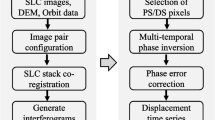Abstract
As the collection of Earth science datasets continues to grow, so too grows the challenge in the ability to collect, interpret, assimilate, compare, and combine them. Stores of data, already enormous, continue to amass. New instruments are built that introduce differences in measurements and retrieval algorithms from previous ones. Data are rarely collocated either spatially or temporally, and rarely represent equivalent quantities even for similarly named parameters. Uncertainties must be understood and accounted for. Formats differ. In the realm of diverse data sources, the analyst each time must become an expert in the data from each source, and that expertise is disseminated in the form of publications (if at all), but analysis tools are not, and must be continually redeveloped. AMAPS addresses each of these areas in a way that provides a breakthrough in the analyst’s ability to efficiently and effectively make use of the vast wealth of data that continues to accumulate. AMAPS is targeted to aerosol data acquisition and analysis. Data from disparate aerosol sources, including the Multi-angle Imaging SpectroRadiometer (MISR), the Moderate Resolution Imaging Spectrometer (MODIS), and the AErosol RObotic NETwork (AERONET), are efficiently retrieved and transformed behind the scenes to a common format via SciFlo. Analysis algorithms for collocation and comparison between sources are generalized so that researchers have access to a common set of tools applied consistently to each data source. AMAPS has established a successful track record in supporting scientific research.



Similar content being viewed by others
References
Ackerman T, Braverman A, Diner D, Anderson T, Kahn R, Martonchik J, Penner J, Wielicki B, Rasch P, Yu B (2004) Integrating and interpreting aerosol observations and models within the PARAGON framework. Bull Am Meteorol Soc 85:1523–1533
Berrick SW, Leptoukh G, Farley JD, Rui H (2009) Giovanni: a web service workflow-based data visualization and analysis system. IEEE Trans Geosci Remote Sens 47(1):106–113
Braverman A, Penner J, Xu L, Paradise S, Chuang K, Wilson B, Manipon G, Xing Z (2007) Comparing MISR and MODIS to output from the IMPACT aerosol and transport model using the aerosol measurement and processing system. Oral presentation, Fall AGU, San Francisco, CA
Chatterjee A (2009) A geostatistical data fusion technique for merging remote sensing observations of aerosol optical thickness. J Geophys Res, in submission
Diner DJ, Beckert JC, Reilly TH, Bruegge CJ, Conel JE, Kahn R, Martonchik JV, Ackerman TP, Davies R, Gerstl SAW, Gordon HR, Muller J-P, Myneni R, Sellers RJ, Pinty B, Verstraete MM (1998) Multi-angle Imaging SpectroRadiometer (MISR) description and experiment overview. IEEE Trans Geosci Remote Sens 36(4):1072–1087
Diner DJ, Ackerman TP, Anderson TL, Bösenberg J, Braverman AJ, Charlson RJ, Collins WD, Davies R, Holben BN, Hostetler CA, Kahn RA, Martonchik JV, Menzies RT, Miller MA, Ogren JA, Penner JE, Rasch PJ, Schwartz SE, Seinfeld JH, Stephens GL, Torrez O, Travis LD, Wielicki BA, Yu B (2004) PARAGON: an integrated approach for characterizing aerosol climate impacts and environmental interactions. Bull Am Meteorol Soc 85:1491–1501
Engel-Cox J, Zell E, Weber S, Hoff R, Zhang H (2008) Applications of the three-dimensional air quality system to Western U.S. air quality: smog blog, smog stories, and Airquest. AAAR/A & WMA Visibility Conference, Paper No. 88, Moab, Utah, April 28–May 2, 2008
Hoff RM, Engel-Cox JA (2008) The three dimensional air quality system (3D-AQS). 2008 IEEE International Geoscience & Remote Sensing Symposium. http://www.igarss08.org/Abstracts/pdfs/1853.pdf
Holben BN, Eck TF, Slutsker I, Tanre D, Buis JP, Setzer A, Vermote E, Reagan JA, Kaufman Y, Nakajima T, Lavenu F, Jankowiak I, Smirnov A (1998) AERONET—a federated instrument network and data archive for aerosol characterization. Remote Sens Environ 66:1–16
Kalashnikova OV, Kahn RA (2008) Mineral dust plume evolution over the Atlantic from MISR and MODIS aerosol retrievals. J Geophys Res 113:D24204. doi:10.1029/2008JD010083
Kinne S, Paradise S (2009) Testing the regional application of site statistics with satellite data. Poster presentation, European Geosciences Union General Assembly 2009, Vienna, Austria
Lary DJ, Remer LA, MacNeill D, Roscoe B, Paradise S (2009) Machine learning and bias correction of MODIS aerosol optical depth. IEEE Geosci Remote Sens Lettr 6(4):694
MISR Quality Statement (2007) http://eosweb.larc.nasa.gov/PRODOCS/misr/Quality_Summaries/L2_AS_Products.html
Paradise S, Braverman A, Cressie N, Kahn R, Wilson B (2007) Long-term global comparisons of aerosol optical depth from MISR, MODIS and AERONET using AMAPS. Oral presentation, Fall AGU, San Francisco, CA
Paradise S, Braverman A, Kahn R, Wilson B (2008) Global aerosol optical depth measurement correction factors and variance estimates for the terra mission. Poster presentation, Fall AGU, San Francisco, CA
Paradise S, Garay MJ, Braverman A, Wilson B (2009) The aerosol measurement and processing system and applications to African studies. IGARSS ’09
Rotman DA, Atherton CS, Bergmann DJ, Cameron-Smith PJ, Chuang CC, Connel PS, Dignon JE, Franz A, Grant KE, Kinnison DE, Molenkamp CR, Proctor DD, Tannahill JR (2004) IMPACT, the LLNL 3-D global atmospheric chemical transport model for the combined troposphere and stratosphere: model description and analysis of ozone and other trace gases. J Geophys Res 109:D04303. doi:10.1029/2002JD003155
Salomonson V, Barnes W, Maymon P, Montgomery H, Ostrow H (1989) MODIS: advanced facility instrument for studies of the Earth as a system. IEEE Trans Geosci Remote Sens 27(4):145–153, J Volcanol Geotherm Res 131:109–121
Wilson BD, Tang BY, Manipon B, Yunck T, Fetzer E, Braverman A, Dobinson E (2005) GENESIS SciFlo: scientific knowledge creation on the grid using a semantically-enabled dataflow execution environment. Peer-reviewed proceedings of SSDBM 2005, pp 83–86
Acknowledgements
The research described in this paper was carried out at the Jet Propulsion Laboratory, California Institute of Technology, under a contract with the National Aeronautics and Space Administration. We would like to thank the NASA Langley Research Center’s Atmospheric Sciences Data Center for their support in hosting the AMAPS services.
Author information
Authors and Affiliations
Corresponding author
Rights and permissions
About this article
Cite this article
Paradise, S., Wilson, B. & Braverman, A. The aerosol measurement and processing system (AMAPS). Earth Sci Inform 3, 159–165 (2010). https://doi.org/10.1007/s12145-009-0042-7
Received:
Accepted:
Published:
Issue Date:
DOI: https://doi.org/10.1007/s12145-009-0042-7




